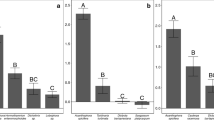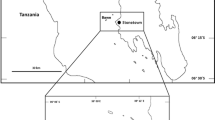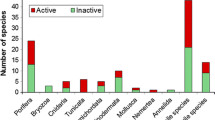Abstract
We investigated the natural products chemistry and feeding deterrent effects of brominated sesquiterpenes produced by Pacific collections of the calcareous tropical green algaNeomeris annulata. Assays conducted with whole algae showed thatN. annulata was not susceptible to grazing by natural populations of herbivorous fishes on Guam. Crude extracts and column chromatography fractions containing the brominated sesquiterpenes deterred feeding by herbivorous fishes at natural concentrations in field assays on Guam. Two majorN. annulata sesquiterpenes isolated from Guam collections and three related sesquiterpenes previously reported from Bermuda all deterred fish feeding at the high end of their natural concentration ranges, with the exception of one metabolite from Bermuda collections of the alga that differed structurally from the other compounds. The results support our hypothesis that the compounds produced byNeomeris function as chemical defenses against herbivores. The alga produces both structural defenses (CaCO3 in the form of aragonite) and secondary metabolites that defend against herbivory by reef fishes.
Similar content being viewed by others
References
Barnekow, D.E., Cardellina, J.H., II, Zektzer, A.S., andMartin, G.E. 1989. Novel cytotoxic and phytotoxic halogenated sesquiterpenes from the green algaNeomeris annulata. J. Am. Chem. Soc. 111:3511–3517.
Burreson, B.J., Woolard, F.X., andMoore, R.E. 1975a. Chondrocole A and B, two halogenated dimethylhexahydrobenzofurans from the red algaChondrococcus hornemanni (Mertens) Schmitz.Tetrahedron Lett. 1975:2155–2158.
Burreson, B.J., Woolard, F.X., andMoore, R.E. 1975b. Evidence for the biogenesis of halogenated myrcenes from the red algaChondrococcus hornemanni Chem. Lett. 1975:1111–1114.
Choat, J.H. 1991. The biology of herbivorous fishes on coral reefs, pp. 120–155,in P.F. Sale (ed.). The Ecology of Fishes on Coral Reefs. Academic Press, San Diego.
Coll, J.C., andWright, A.D. 1989. Tropical marine algae. VI. New monoterpenes from several collections ofChondrococcus hornemanni (Rhodophyta, Gigartinales, Rhizophyllidaceae).Aust. J. Chem. 42:1983–1993.
Dolinger, P.M., Ehrlich, P.R., Fitch, W.L., andBreedlove, D.E. 1973. Alkaloid and predation patterns in Colorado lupine populations.Oecologia 13:191–204.
Fuller, R.W., Cardellina, J.H., II, Kato, Y., Brinen, L.S., Clardy, J., Snader, K.M., andBoyd, M.R. 1992. A pentahalogenated monoterpene from the red alga,Portieria hornemanni, produces a novel cytotoxicity profile against a diverse panel of human tumor cell lines.J. Med. Chem. 35:3007–3011.
Hay, M.E. 1984. Predictable spatial escapes from herbivory: How do these affect the evolution of herbivore resistance in tropical marine communities?Oecologia 64:396–407.
Hay, M.E. 1991. Fish-seaweed interactions on coral reefs: Effects of herbivorous fishes and adaptation of their prey, pp. 96–119,in P.F. Sale (ed.). The Ecology of Fishes on Coral Reefs. Academic Press, San Diego.
Hay, M.E., Paul, V.J., Lewis, S.M., Gustafson, K., Tucker, J., andTrindell, R.N. 1988. Can tropical seaweeds reduce herbivory by growing at night? Diel patterns of growth, nitrogen content, herbivory, and chemical versus morphological defenses.Oecologia 75:233–245.
Hiatt, R.W., andStrasburg, D.W. 1960. Ecological relationships of the fish fauna on coral reefs of the Marshall Islands.Ecol. Monogr. 30:65–127.
Horn, M.H. 1989. Biology of marine herbivorous fishes.Oceanogr. Mar. Biol. Annu. Rev. 27:167–272.
Hutchings, P.A. 1986. Biological destruction of coral reefs.Coral Reefs 4:239–252.
Ichikawa, N., Naya, Y., andEnomoto, S. 1974. New halogenated monoterpenes fromDesmia (Chondrococcus) hornemanni.Chem. Lett. 1974:1333–1336.
Lubchenco, J., andGaines, S.D. 1981. A unified approach to marine plant-herbivore interactions. I. Populations and communities.Annu. Rev. Ecol. Syst. 12:405–437.
Meyer, K.D. 1991. Intraspecific variation in the concentration of secondary metabolites in four species of green algae and its effects on feeding by herbivorous fishes. MS thesis. University of Guam.
Meyer, K.D.,Paul, V.J.,Sanger, H.R., andNelson, S.G. 1993. Effects of seaweed extracts and secondary metabolites on feeding by the herbivorous surgeonfishNaso lituratus. Coral Reefs In press.
Paul, V.J. 1987. Feeding deterrent effects of algal natural products.Bull. Mar. Sci. 41:514–522.
Paul, V.J. 1992. Seaweed chemical defenses on coral reefs, pp. 24–50,in V.J. Paul (ed.). Ecological Roles of Marine Natural Products. Comstock Publishers, Ithaca, New York.
Paul, V.J., andFenical, W. 1986. Chemical defense in tropical green algae, order Caulerpales.Mar. Ecol. Prog. Ser. 34:157–169.
Paul, V.J., andFenical, W. 1987. Natural products chemistry and chemical defense in tropical marine algae of the phylum Chlorophyta, pp. 1–29,in P.J. Scheuer (ed.). Bioorganic Marine Chemistry, Vol. 1. Springer-Verlag, Berlin.
Paul, V.J., andHay, M.E. 1986. Seaweed susceptibility to herbivory: Chemical and morphological correlates.Mar. Ecol. Prog. Ser. 33:255–264.
Paul, V.J., andVan Alstyne, K.L. 1988a. Chemical defense and chemical variation in some tropical Pacific species ofHalimeda (Halimedaceae; Chlorophyta).Coral Reefs 6:263–269.
Paul, V.J., andVan Alstyne, K.L. 1988b. Antiherbivore defenses inHalimeda. Proceedings, 6th International Coral Reef Symposium, Vol. 3, pp. 133–138.
Paul, V.J., andVan Alstyne, K.L. 1992. Activation of chemical defenses in the tropical green algaeHalimeda spp.J. Exp. Mar. Biol. Ecol. 160:191–203.
Paul, V.J., Hay, M.E., Duffy, J.E., Fenical, W., andGustafson, K. 1987. Chemical defense in the seaweedOchtodes secundiramea (Rhodophyta): Effects of its monoterpenoid components upon diverse coral-reef herbivores.J. Exp. Mar. Biol. Ecol. 114:249–260.
Randall, J.E. 1967. Food habits of reef fishes of the West Indies.Stud. Trop. Oceanogr. Miami 5:655–847.
Schupp, P.J., andPaul, V.J. 1993. Calcification and secondary metabolites in tropical seaweeds: Variable effects on herbivorous fishes.Ecology In review.
Sokal, R.R., andRohlf, F.J. 1981. Biometry. W.H. Freeman, New York.
Whitham, T.O. 1983. Host manipulation of parasites: Within-plant variation as a defense against rapidly evolving pests, pp. 15–41,in R.F. Denno and M.S. McClure (eds.). Variable Plants and Herbivores in Natural and Managed Systems. Academic Press, New York.
Whitham, T.G., Williams, A.G., andRobinson, A.M. 1984. The variation principle: individual plants as temporal and spatial mosaics of resistance to rapidly evolving pests, pp. 15–51,in P.W. Price, C.N. Slobodchikoff, and W.S. Gaud (eds.). A New Ecology: Novel Approaches to Interactive Systems. John Wiley & Sons, New York.
Woolard, F.X., Moore, R.E., Van Engen, D., andClardy, J. 1978. The structure and absolute configuration of Chondrocolactone, a halogenated monoterpene from the red alga,Chondrococcus hornemanni, and a revised structure for Chondrocole A.Tetrahedron Lett. 1978:2367–2370.
Author information
Authors and Affiliations
Rights and permissions
About this article
Cite this article
Paul, V.J., Cronan, J.M. & Cardellina, J.H. Isolation of new brominated sesquiterpene feeding deterrents from tropical green algaNeomeris annulata (Dasycladaceae: Chlorophyta). J Chem Ecol 19, 1847–1860 (1993). https://doi.org/10.1007/BF00983791
Received:
Accepted:
Issue Date:
DOI: https://doi.org/10.1007/BF00983791




